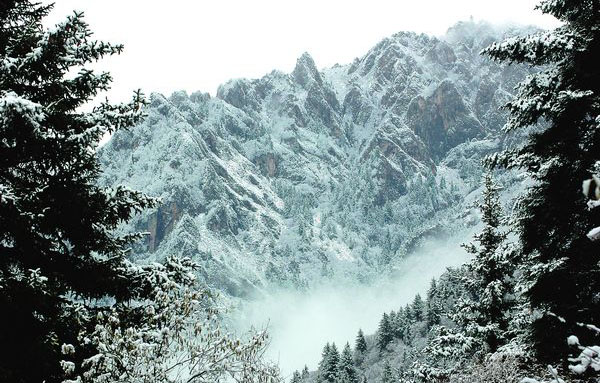The Overview of the Reserve
South of Lanzhou, the capital of the Gansu Province, the southwestern corner of the extensive loess plateau is surrounded by large mountain complexes. The Tao River originates from the mountains south of Lanzhou and flows in a northerly direction before entering the Yellow River upstream of Lanzhou. The Lianhuashan Natural Reserve is located on the right side of the Tao River about 170km south of Lanzhou. This is where the Tao River Valley cuts through the last mountain chain before reaching the loess plateau. The reserve consists of an impressive chain of peaks partially covered with beautiful mixed forests.
Fields surrround the small villages within the reserve
General Properties of the Reserve
The reserve is 11,691 ha in size and is located in the Kangle District, south of Lanzhou. Itwas founded in 1983 to protect unique forest and forest steppe ecosystems in this province, where extensive primary forests are very rare. As in other localities in China, this forest remnant has been preserved by the fact that the summit of Lianhuashan (3,578 m) was a holy site of in the Buddhist religion. It was the center of a system of temples connected by steep mountain trails used by the pilgrims and of holy caves inside the limestone mountains. In contrast, the primeval forests around Lanzhou and along the Yellow River were transferred to agricultural land 500-700 years ago!

Autumn colours in the forest-view from the trail to the summit
The high diversity of habitats, plants and animals results in part from its location in the vicinity of four to six zoogeographic subregions: the Loess plateau subregion in the East, the East steppe subregion in the Northwest, the Qinghai-South Xizang subregion in the East and the Western desert subregion in the North. In addition, the Southwest mountain subregion and the Western mountain subregion are not far to the South. The reserve itself belongs to the “alpine forest steppe” subregion. The climate is continental in autumn, winter, and early spring and the surroundings look like a semidesert in that time. However, it is influenced by monsoon rains in summer, with maximum precipitation in July. In winter, the 20-30 cm snow in valleys at 2100 m and the 60 cm snow above 3000 m is common, but not always. The average annual temperature in the reserve is 5.1-6.0º C, with extremes of 34º C and -27.1º C at an altitude of 2100 m. The climate is semiarid and, at the higher elevations, the annual precipitation is about 650 mm.

Lianhuashan in October-early snow covers the highest peaks
Only about 30 % of the reserve is forest, mainly on the northern slopes. The rest is agricultural land. Typically small fields are separated by hedges on artificially constructed terrace systems surrounding the villages, with small houses made of loess and seldom of stones. The natural forest area is 2,680 ha and of the boreal type. Part of this area consists of the first generation of trees, following logging of the original virgin forest. To date, about 2000 ha has been replanted, at a rate of about 160 ha annually. The major vegetation types on the reserve are: selectively cut and uncut submature forests (28%), young forest (10%), shrublands (19%) and grassland, croplands, and villages (43%). Planted pine and spruce trees originate from the reserve; small numbers of larch have been introduced from northeastern China. The young (40-60 years old) mixed forest in the study area is dominated by spruces (36%),firs (23%), willows (23%), and birches (14%). Ground vegetation is variable, from little vegetation to dense bushes of a great variety of species, and also grasses, arrow bamboo, forbs, and mosses. The southerly slopes are dominated mostly by grasses, but some shrubs, particularly willows and sea buckthorn, occur on mesic sites.

Grazing yaks in the reserve-a typical situation in summer
About 10,000 inhabitants belonging to the Han Chinese, the Hui and to a lesser extent the Tibetan nations live in 13 villages in the reserve. They obtain their livelihood from the natural resources of the reserve. Problems from this anthropogenic impact include partial overgrazing and illegal timber harvest. One of the main activities of the 80 coworkers and rangers of the reserve is the protection of the natural resources, such as prohibiting or reducing the illegal cutting of trees. To support these activities, several small cabins in the mountains are occupied by rangers all year long. The station of Shahetan, at 2,850 m, became the base for our scientific fieldwork and a trail system was established to study the Chinese grouse and other birds.

An old typical village, Shanshenmiao, at 2200m in the reserve
